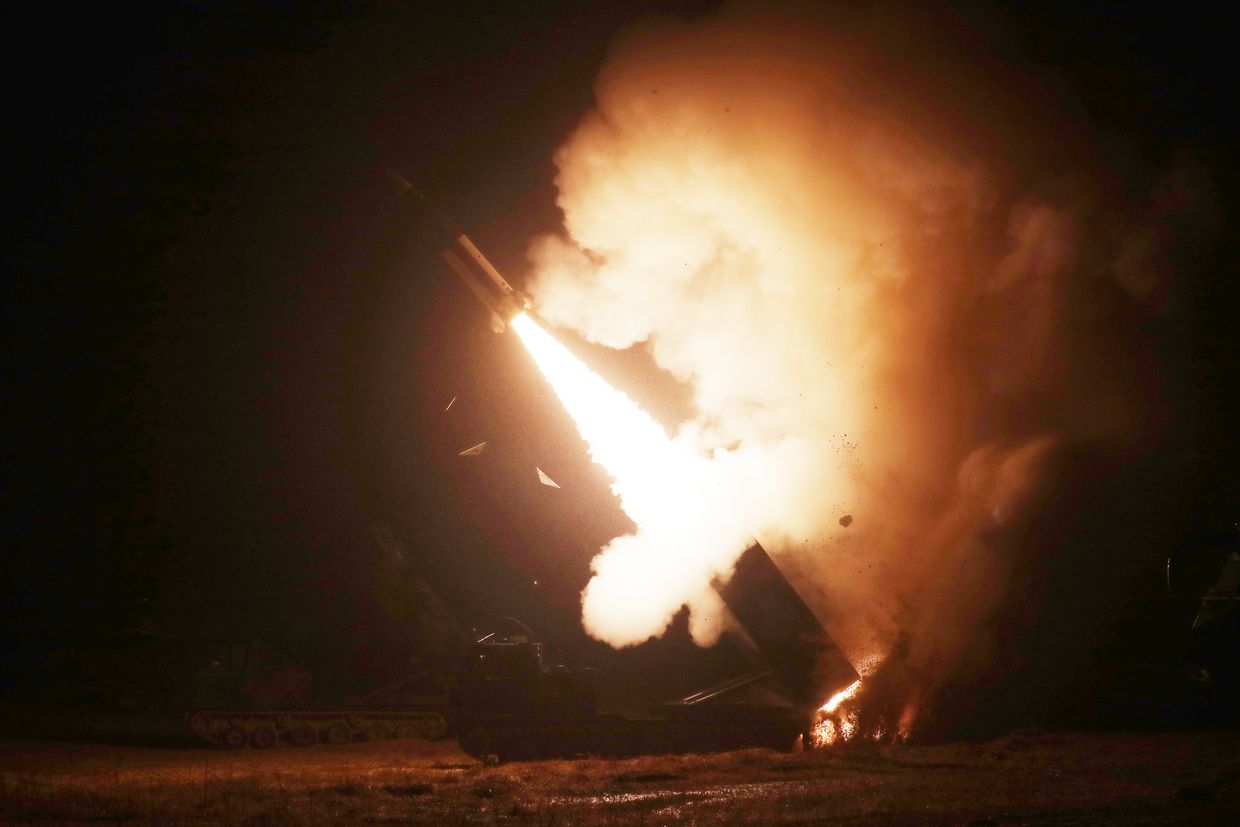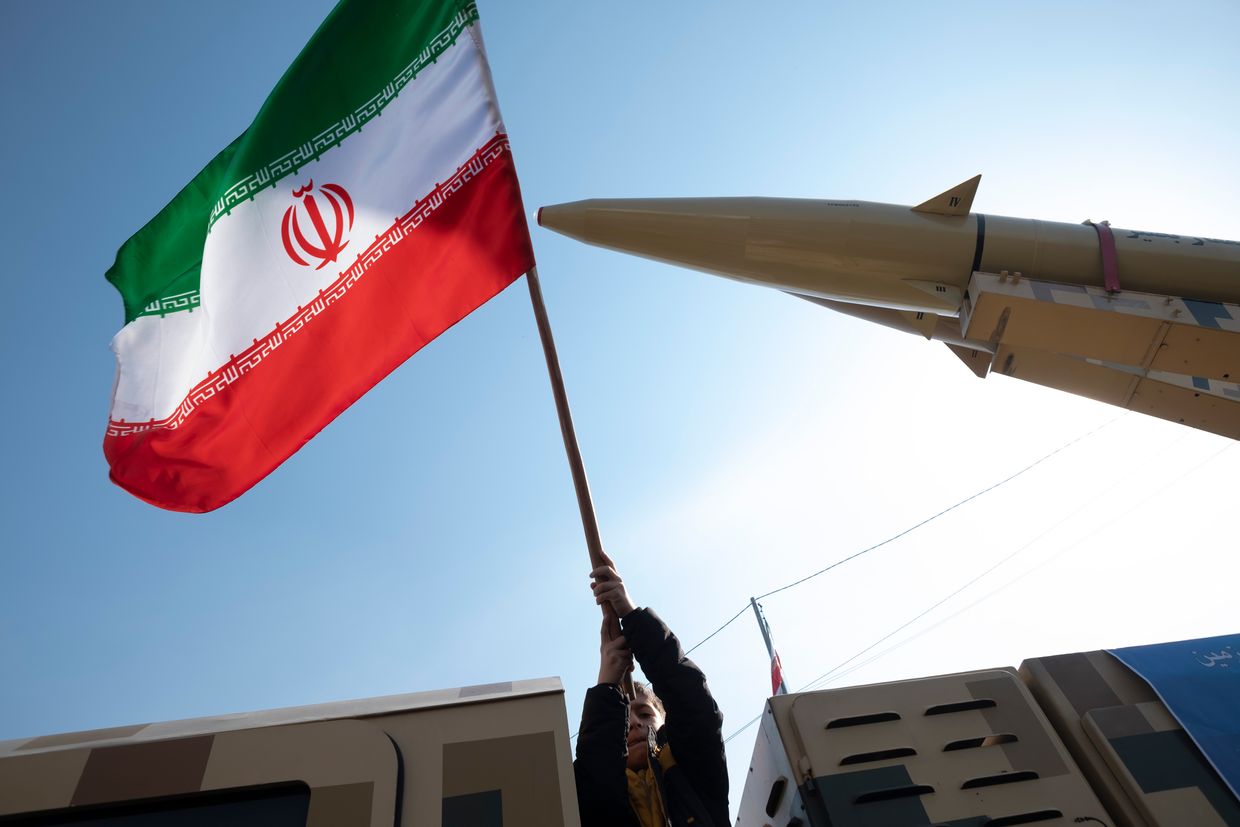
Ukraine’s air defense boosted by 17 IRIS-Ts, but Iranian ballistic missiles still a threat, experts say
Soldiers standing guard in front of a IRIS-T SLM air defence system prior to the arrival of German Chancellor Olaf Scholz and other German officials during the operative launch of the Bundeswehr's first IRIS-T SLM air defence system at the Todendorf military base in Panker, Germany on Sept. 4, 2024. (Gregor Fischer/Getty Images)
Ukraine's continued requests to Western allies for more air defenses were answered in part this week, with the announcement that Germany has ordered an additional 17 IRIS-T air defense systems for Kyiv.
And the timing couldn't be more critical – an ongoing campaign of aerial strikes on Kharkiv, devastating attacks like that on Ukraine's largest children's hospital in July, a strike on Poltava earlier this week that killed at least 55 people, and an attack on Lviv the day after, repeatedly highlight the shortcomings in the country's air defenses.
"Russia continues to wage a cowardly war against civilians, which constitutes war crimes." President Volodymyr Zelensky wrote on X, reacting to the biggest Russian mass attack across Ukraine that killed seven people and injured nearly 50 on Aug. 26, using a total of 236 missiles and drones.
Berlin launched an initiative to bolster Ukraine's air defense in April, and has become one of Ukraine's leading suppliers of systems.
"This shows that German support for Ukraine is not letting up," German Chancellor Olaf Scholz said on Sept. 4 when announcing the latest batch of 17 IRIS-Ts.
According to Scholz, Ukraine already has seven which have been used to shoot down more than 250 Russian missiles and drones.
But according to experts who spoke to the Kyiv Independent, while welcome, the IRIS-Ts will be unable to protect from something that has become an increasing concern in recent days – Iranian ballistic missiles.
What do we know about the IRIS-T?
By 2026, Ukraine should have received 24 IRIS-T systems from Germany — 12 of medium-range versions, IRIS-T SLM, and 12 short-range, IRIS-T SLS — according to Bloomberg.
"The numbers are significant," Fabian Hoffmann, a doctoral research fellow at the University of Oslo who specializes in missile technology, told the Kyiv Independent, adding it will be more than Germany or any other country deploys.
"Ukraine will probably be the largest operator of IRIS-T SLM for a while," he added.
The short-range system can hit a target at a distance of 12 km (8 miles) and at an altitude of up to 8 km (4 miles), while the medium-range system can reach targets at 40 km (24 miles) and at an altitude of 20 km (13 miles).
The IRIS-T launchers, which can carry eight missiles, are portable and can be transported on tracked platforms or trucks made by its German manufacturer, Diehl Defense.

"One of the IRIS-T's advantages is its mobility, which improves survivability," Hoffman said.
The missiles – which can reach a speed of around Mach 3 (1,020 meters per second) – are launched vertically, meaning there are no blind spots directly above the system.
They are equipped with a controlled thrust vector system that improves maneuverability, and an infrared guidance system that responds to heat radiated by the target (IRIS-T stands for "infrared imaging system tail/thrust vector-controlled.")
The missile is also capable of detecting heat traps, which Russia has equipped some cruise missiles with in order to make them harder to intercept.
Hoffmann highlighted the TRML 4D air surveillance radar used for the IRIS-T air defense system, which performs well including in so-called "cluttered environments."
"If you scan for something like cruise missiles or drones that fly fairly close to the ground, there will be trees, mountains, many buildings in the way, and you have to filter those out to discriminate the actual threat," Hoffmann said.
"The TRML is long-range with a great ability to filter out that clutter and a good ability to track incoming targets and then guide the interceptor to it," he added.
However, this radar, like the system itself, is not so effective against some of the weapons used by Russia in its attacks against Ukraine.

What air targets can't IRIS-T shoot down?
The German-made system is optimized to defend against low-flying subsonic and low radar cross-section targets like cruise missiles, but it is not capable of intercepting a ballistic missile, according to experts.
And in most of its mass attacks, Russia has the highest success rate with ballistic missiles, John Hardie, deputy director of the Russia Program at the Foundation for Defense of Democracies, told the Kyiv Independent, adding that Ukraine so far relies mainly on the U.S.-made Patriot air defense system, to protect itself from such threats.
Ballistic missiles such as the Russian Iskander M or Kinzhal approach from a high altitude — up to 50 kilometers (31 miles) and 20 kilometers (12 miles) respectively — and then descend at high speed, up to 3,200 kilometers per hour.
"If you want to take down a ballistic missile, you also need to incorporate some type of terminal guidance, so the interceptor can autonomously or independently course correct over the last couple of meters," Hoffmann said.
"Again, that's not given with IRIS-T, which is why they will not really be able to defend against ballistic missiles," he added.
The increased ballistic threat
While Russia has regularly fired its own ballistic missiles such as the Iskander and the Kinzhal against Ukrainian cities since the start of the full-scale invasion, recent news reports suggest the use of such weapons could soon increase.
According to the Wall Street Journal (WSJ) on Sept. 6, Iran has sent an unknown number of short-range ballistic missiles to Russia, a move the U.S. has described as a "dramatic escalation" in Tehran's support for Moscow's full-scale war against Ukraine.
"These more strategic weapons would basically suck up interceptor missiles, and when it comes to defending against ballistic missiles, you can only use certain systems," Fabian Hinz, a research fellow for defense and military analysis at the International Institute for Strategic Studies, told the Kyiv Independent for a previous article.
"Ukraine has the Patriot air defense system, but the numbers of interceptors are limited so that could potentially be a challenge if you have large numbers of Iranian missiles."

So despite arriving in significant numbers, the IRIS-T system would not be effective in dealing with an increased threat from Iranian ballistic missiles.
But they will still be useful – the system can effectively shoot down low-flying targets, such as aircraft, helicopters, cruise missiles, and drones, which Russia also frequently uses to attack Ukraine.
In August alone, Ukraine's Ground Forces shot down five airplanes, two helicopters, 1,539 drones, and 150 missiles, according to Oleksandr Pavliuk, Ukraine's Ground Forces commander.
"These systems are important for augmenting Ukrainian air defense, particularly given Ukraine's shortage of interceptors for its Soviet-made systems," Hardie said.
However, despite their effectiveness against low-flying targets and increase in supplies from allied countries, the number of IRIS-Ts is still insufficient for Ukraine's needs.
"The numbers (of German supply) are rather significant, at least compared to what other countries currently deploy or plan to deploy," Hoffman said.
"Unfortunately, that still does not mean it is enough in the Ukrainian context."












